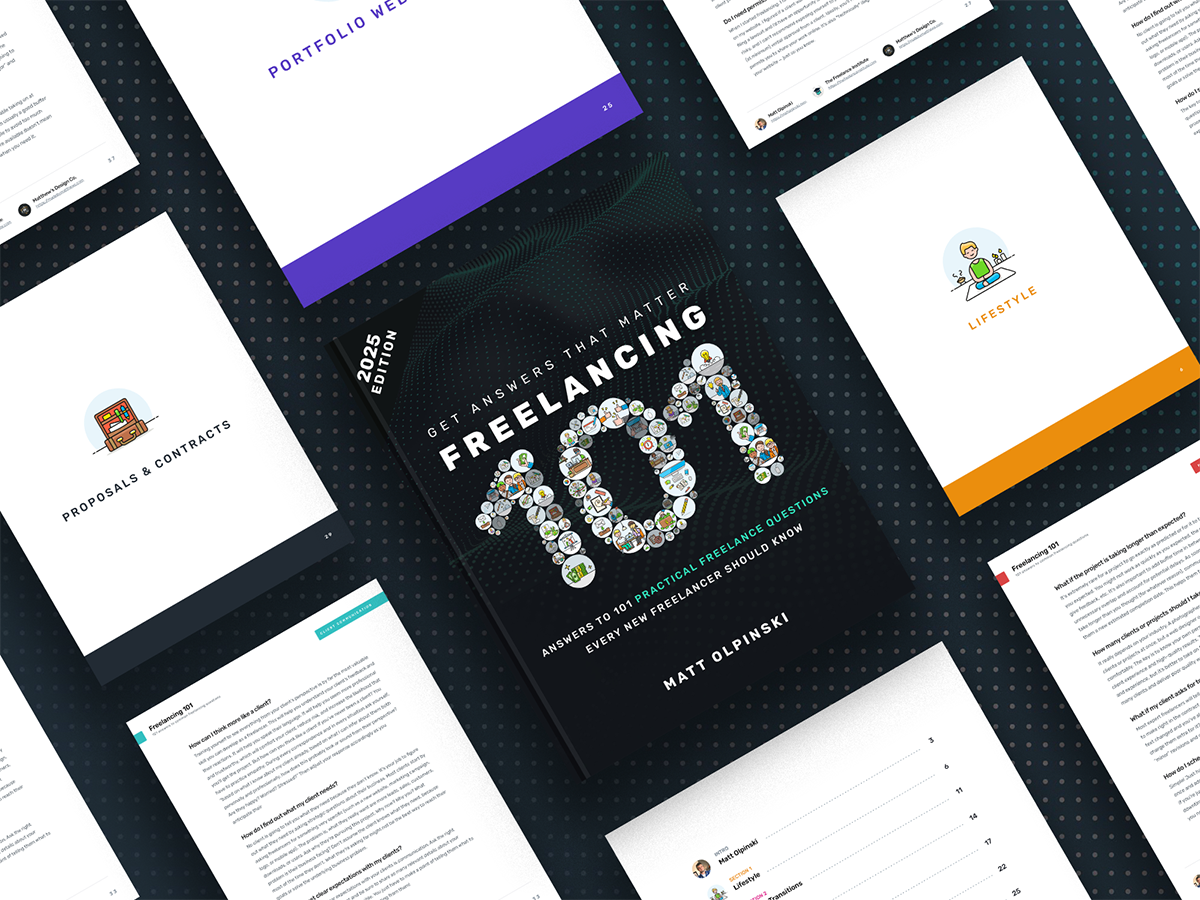Freelancing Through Economic Turmoil — A Guide to Life After Layoff
Laid off from your tech job? Learn how to pivot into freelancing with practical tips on mindset, money, positioning, and building momentum.


New to freelancing? Start here with my FREE 100+ tip guide.
Price your services, find better clients, and avoid beginner mistakes all in one clear, practical book.
The tech industry has been absolutely gutted over the last three years. Companies that once prided themselves on hiring top talent are now cutting teams by the thousands.
An estimated 500,000 people have lost their jobs since 2022. Over 2,000 tech companies have downsized. Entire teams were wiped out overnight. High-performers were laid off with no warning. Roles were eliminated while projects were still being worked on.
My LinkedIn feed has been an endless cascade of trauma. I’ve seen hundreds of posts from people who have lost their jobs and are struggling to find employment. I’ve even heard of people applying to hundreds or even thousands of job offers, unable to secure a position.
If you’ve been laid off and are thinking about freelancing, this article is for you. Transitioning from full-time employment to part-time or full-time freelance is a massive career transition, so it’s important that you approach it with clarity and strategic thinking.
Is Freelancing Right for You?
Before you decide what’s next, give yourself a moment to breath. Getting laid off is emotionally and financially destabilizing. You didn’t plan for this. You’re not going to feel “ready” for much of anything — and that’s okay.
If you’re brand new to freelancing, you probably have questions like:
- Should I freelance part-time or full-time?
- What should I charge — hourly, daily, or fixed?
- Do I need to form an LLC?
- Where do I even find clients?
- How do I write a proposal?
- Do I need to have my own website?
These are normal questions, and we’ll touch on some of them in this article. If you want answers to over 100 questions like this, please check out my free book Freelancing 101 which has 52 pages packed with insights new freelancers.
Freelancing can be incredibly freeing, but it’s also a massive responsibility. It might be easy to imagine yourself choosing your own hours, setting your own rates, and skipping the office politics. You might even resent your company for letting you go. But freelancing involves unpredictable income, self-employment taxes, chasing down unpaid invoices, determination, self-discipline, and so much more.
I didn’t take the traditional path into freelancing — or out of it. I freelanced during college, took a full-time job after graduation, kept freelancing on the side, then began full-time freelancing in 2015. In 2018, I started my own company as an S Corp. Three years later, I decided to take a full-time job at Instacart. I’ve had just about every experience possible, and I know that everyone’s career path looks different.
Most people think freelancing has to be all or nothing, but that’s a common misconception. You can pick up a few freelance gigs while searching for your next role. You can take a part-time job in a completely unrelated industry just to pay the bills while you re-vamp your portfolio. You can freelance full-time for a year, then go back to a salaried role when the opportunity arises. If you’re willing to take some risks, your career can feel more like a playground than a ladder.
And if you’ve made it this far into the article, I’m going to assume you’re seriously considering freelancing — or already starting. So from here on out, we’re going to focus on helping you take action
✨ Freelance InsightIf you’re willing to take some risks, your career can feel more like a playground than a ladder.
Revisit Your Finances & Portfolio
Freelancing changes your financial world — including taxes, insurance, and pay cycles. If you’ve never billed a client before, this part can catch you off guard.
Start by understanding your runway: how much money you need each month, where you can cut spending, and how taxes or health insurance might change now that you’re on your own.
From there, factor in self-employment taxes, private health insurance, and any new tools or services you’ll need to operate as a solo business.
If you don’t have a portfolio, now’s the time to make one. It doesn’t have to be fancy — even a single page is a solid start. Make sure you’re talking to your ideal clients and treating your website like a professional sales tool, not a personal highlight reel.
Add a project intake form, not just a “contact me” link or message box. Learn more about that in my article about supercharging your website’s contact form.
Use personal projects if you need to. Redesign something old or something that might be restricted by NDA. If you’ve done work at a past job you’re proud of, anonymize it.
Swap out company names for something like “a fintech startup” or “an enterprise HR platform.” That keeps things professional without revealing sensitive info. Focus on showing your thinking and the results your work delivered. And if you’re a designer or developer, try to host it yourself — it signals that you know your way around the tools.
Get the Word Out
Next, let people know you’re available. Don’t assume they already know. You have to be proactive, even if it’s a little uncomfortable. Leverage your layoff as a strong communication tactic rather than using it to complain.
Talk to former coworkers, managers, friends, even old classmates — these are the people most likely to open a door for you. Post on LinkedIn. Email your network. Tell your local community. Don’t be shy.
Most freelancers don’t find clients through job boards. They find them through people who already trust them or through their own portfolio website.
And don’t just stick to the open internet. Send personal messages. A quick text to a friend or a Slack message to a former teammate can go a long way. The best leads often come from unexpected places.
If freelancing feels too risky right now, look for a side door. Pick up a temp contract. Teach what you know. Consult part-time while you job hunt. None of these paths are beneath you. Short-term gigs or adjacent roles can buy you time and clarity while you figure out your next move. And who knows — one of them might turn into something bigger than you expected.
Get Started with Freelance Work
You don’t need to land a $10,000 project to start freelancing. In fact, trying to land a massive client right away is probably the wrong move. If you’re new to freelancing, your first goal should be to build momentum — not to prove you’ve already made it.
There are plenty of ways to get your foot in the door without taking on huge risk. Subcontracting through a design or development agency can get you paid work without handling the client relationship directly. Offering one-off consulting, audits, or coaching lets you work with clients in smaller chunks. Picking up overflow work from former coworkers or managers is another low-friction way to get started.
You can also create and sell small digital products, teach on platforms like Skillshare or Gumroad, or take on temporary freelance contracts while you continue applying to full-time jobs. These aren’t backup plans. They’re real ways to gain confidence, sharpen your process, and start earning as a self-employed professional.
Most freelancers don’t “launch” their business — they build it one step at a time. The key is to start where you are, use the network you already have, and find the smallest possible way to deliver value. From there, you’ll start learning what kind of work you actually enjoy, what your clients need, and how to grow on your own terms.
Strengthen Your Position
Once you’ve taken those first steps, it’s time to level up. That means thinking less like a task-doer and more like a problem-solver.
The more intentional you are, the more recession-proof you become. Focus on work that directly impacts business goals — the kind of projects that don’t get paused when budgets tighten. Position yourself as a consultant, not a contractor. Help clients make decisions, not just deliver assets. The more you think like a business partner, the less likely you are to be seen as disposable.
Now’s a good time to rethink what you offer and how you offer it. Are your services clearly positioned? Do they reflect where the market is going, not just where it’s been? Can you package your skills in a way that solves urgent problems for your ideal clients? Maybe that means productizing your services. Maybe it means niching down. Or maybe it means expanding into new areas entirely.
Don’t just work in your business. Start working on it. Build systems. Optimize your process. Think like an owner, not just a freelancer. And if you’re more into products than clients, tools like ChatGPT and Midjourney make it easier than ever to create and sell digital goods.
You might not earn six figures your first year. That doesn’t mean you’re failing. It means you’re building. Freelancing is a long game, not a quick fix. Progress looks different for everyone, especially during uncertain times.
What Not to Do After a Layoff
- Don’t rush into freelancing just to feel productive. Take a beat. Make sure you’re choosing it — not just reacting to a bad situation.
- Don’t start freelancing without knowing your numbers. You need to understand your financial runway and minimum monthly income.
- Don’t underprice yourself just to win projects. Desperation pricing is hard to undo and makes you look inexperienced.
- Don’t try to do everything at once. You don’t need a perfect portfolio, logo, website, and legal entity on day one.
- Don’t go silent. Isolation kills momentum. Stay in touch with your network, even if it’s just to share what you’re working on.
- Don’t ignore the emotional side. Layoffs suck. Pushing through without processing it will catch up with you later.
Turning Uncertainty Into Opportunity
Freelancers who hustle through uncertainty often come out way ahead. If you’re forced to get creative, learn fast, and stretch your comfort zone — that’s a feature, not a bug. The skills you build during a downturn will compound once the market recovers.
This could be the beginning of something better. It might not feel that way right now, but I’ve seen it happen again and again. So if you’re on the edge of freelancing — curious but cautious, start putting in the work and freelancing can take you further than you think.





